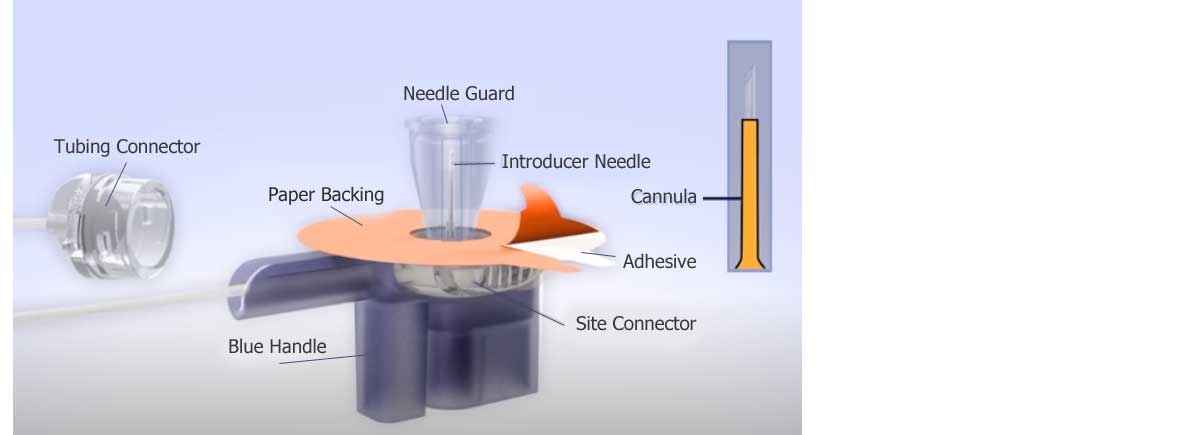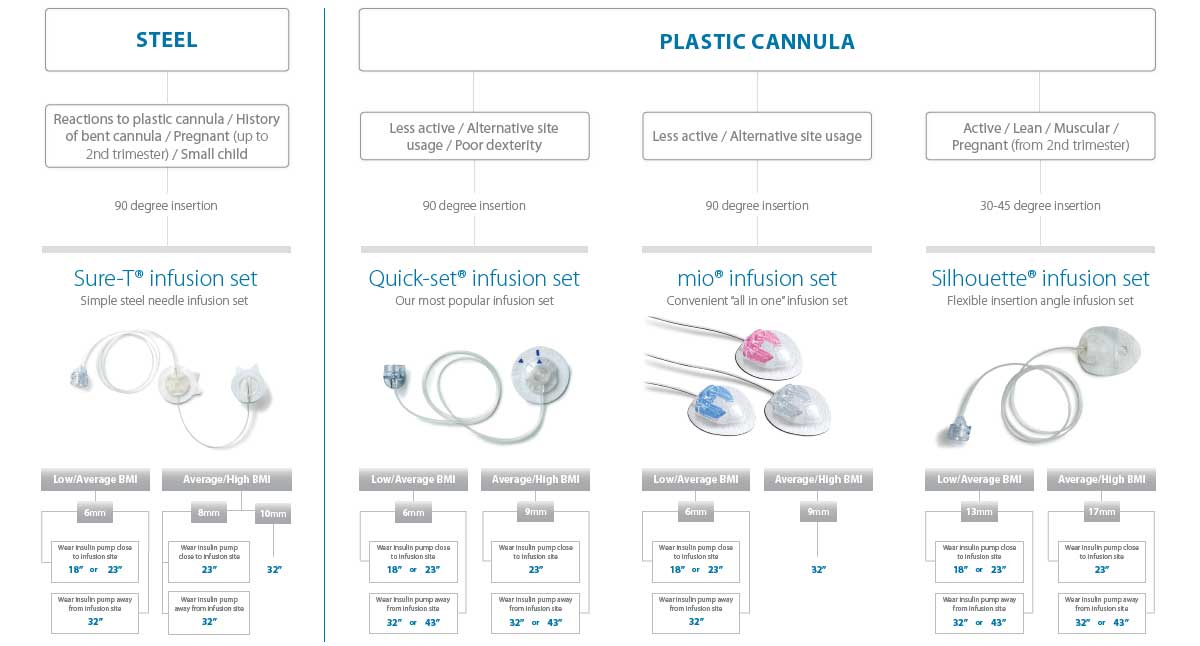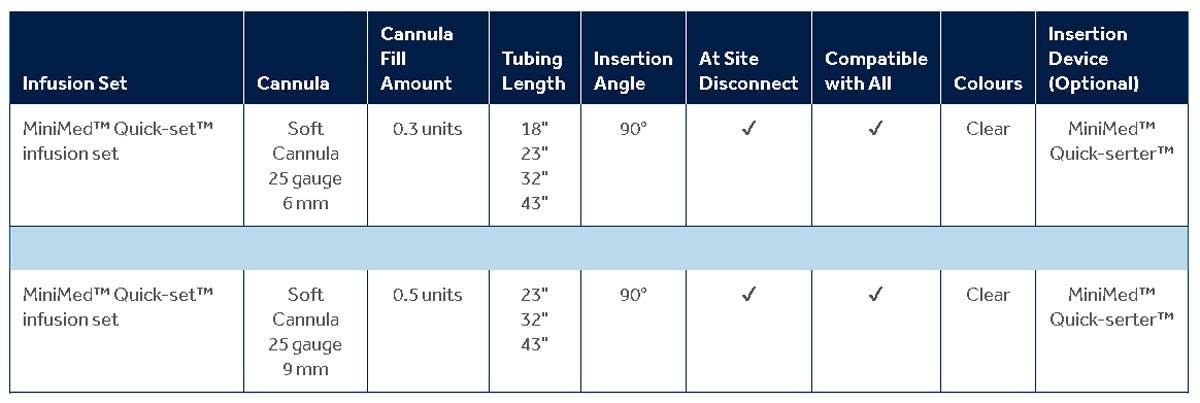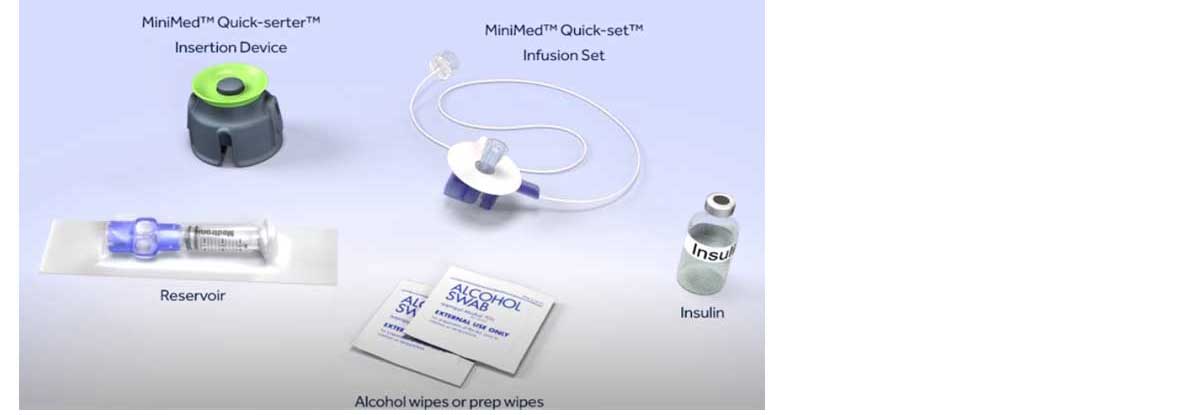Medtronic MiniMed Quick-Set Infusion Sets for insulin delivery in conjunction with insulin pumps in the MiniMed Paradigm family and MiniMed 530G. There are two different types of infusion kits: MiniMed luer lock connection and the other with the Paradigm connection for the Medtronic Quick-Set Paradigm Infusion Set. These Medtronic infusion kits offer customization with varying tubing lengths and a soft, tapered plastic cannula. Medtronic infusion sets utilize a Safe Needle Disposal System created to prevent accidental needlesticks during disposal.
Medtronic QuickSet Infusion Set utilizes a plastic cannula and a 90-degree insertion angle. It is the best-selling infusion set from Medtronics. The infusion set supports low to average BMI with a 6 mm cannula option and four length options: 18, 23, 32, or 43 inches. There is also a design that supports average to high BMI using a 9 mm cannula with three length options: 23, 32, or 43 inches. The shorter-length options of 18 to 23 inches support wearing the insulin pump close to the infusion site. The more extended length options of 32 to 43 inches support wearing the insulin pump further away from the infusion site.
Anatomy of the MiniMed Quick-Set Infusion Set

The Medtronic Quick Set Infusion Set for sale comes in a box of 10. It comes with pre-applied adhesive to help achieve a low profile. It offers a 90-degree insertion and easily inserts using an optional Quick-serter tool. There are ideal locations on the body to place the infusion. Below is a graphic that indicates the best infusion sites.
Best Infusion Sites

Features and Benefits
- Works with Insulin Pumps for Automatic Insulin Delivery
- Low-Profile Design
- Easy to Apply
- Variety of Tube Lengths
- Variety of Cannula Lengths
- At Site Tubing Disconnect
- 90° Insertion Angle
- Soft, Tapered Cannula
- Prevents Accidental Sticks
- Pre-Attached Adhesive
- Discreet Wear
- Provides Optimal Insertion
- Designed for Comfort
Product Specifications
- Manufacturer: Medtronic
- Brand: MiniMed
- Product Numbers (with Luer): MMT-390, MMT-392, MMT-393
- Product Numbers (Paradigm): MMT-386, MMT-396, MMT-397, MMT-398, MMT-399
- Tube Length Options: 23, 32, 43 Inches
- Cannula Lengths: 6, 9 mm
- Quantity: Box of 10
- Application: Insulin Infusion Therapy
Selecting the Best Infusion Kit

- Smiths Medical Cleo 90 Infusion Set - Single-use infusion set
- Silhouette Kit - Flexible Angle
- Silhouette Paradigm Kit - for the Paradigm Insulin Pump
Indications
- Patients requiring continuous delivery of basal insulin
- Patients requiring administration of insulin boluses
- Patients requiring management of Type 1 diabetes mellitus
- Patients 7 years or older requiring insulin
- Patients with a prescription
- Infusion kits use for subcutaneous applications only
Contraindications
- Not for children less than 7 years old
- Patients who require less than eight units of insulin daily
- Patients whose vision or hearing does not allow recognition of pump signals and alarms
- Infusion kits are not for intravenous (IV) infusion or the infusion of blood or blood products
- Insulin pump therapy is not for those who are unwilling to perform at least four blood glucose tests daily
Cautions
Do not use the Suspend function on low feature to prevent or treat low glucose. Always confirm your sensor glucose reading using your BG meter. Follow the instructions of your healthcare professional to manage low glucose. Hypoglycemia may result from using Suspend on low alone to prevent or treat low glucose. If an infusion site becomes irritated or inflamed, remove the infusion kit and place it in a new location.
Possible Side Effects
- Bleeding
- Bruising
- Discomfort or pain
- Irritation
- Occlusions that can interrupt insulin delivery and lead to hyperglycemia or diabetic ketoacidosis
- Rash
- Skin irritation or redness
Infusion Kit Comparison

Product Use Instructions
- If insulin or any liquid gets inside the tubing connector, it can temporarily block the vents that allow the pump to prime the infusion set correctly. This blockage may result in the delivery of too little or too much insulin, resulting in hyperglycemia or hypoglycemia. If this occurs, start over with a new reservoir and infusion set.
- Do not reinsert the introducer needle into the infusion kit. Reinsertion may cause tearing of the soft cannula, which may result in unpredictable medication flow.
- If while infusing insulin your blood glucose level becomes unexplainably high or an occlusion alarm occurs, check for clogs and leaks. If in doubt, change the infusion kit because the soft cannula may be dislodged, crimped, or partially clogged. Should any of these problems arise, make a plan with your healthcare professional for rapidly replacing insulin. Test the blood glucose level to ensure the problem corrects.
- Reuse of the infusion kit may cause damage to the cannula or needle and lead to infection, site irritation, or inaccurate medication delivery.
- Dispose of the transfer guard safely in a sharps container.
- While inserted, never prime the kit or attempt to free a clogged line. You may accidentally inject too much medication.
- Do not use disinfectants, perfumes, or deodorants with the infusion kit as these may affect the integrity of the kit.
- Dispose of the infusion set and introducer needle safely in a sharps container after a single use. Do not clean or re-sterilize.
- Store infusion kits in a cool, dry place. Do not leave the infusion kits in direct sunlight or inside a vehicle.
- Only use reservoir and infusion sets manufactured or distributed by Medtronic Diabetes. The pump has undergone extensive testing to confirm proper operation when used with compatible reservoirs and infusion sets made or distributed by Medtronic Diabetes. There is no guarantee of proper pump operation if used with reservoirs or infusion sets offered by third parties. The manufacturer is not responsible for any injury or malfunctioning of the pump that may occur in association with such use.
- Use aseptic techniques when temporarily disconnecting the kit and consult your healthcare provider on how to compensate for missed medication when disconnected.
- If infusing insulin, carefully monitor your blood glucose levels when disconnected and after reconnecting.
- The reservoir and the transfer guard are sterile, non-pyrogenic, and for single use only.
- Do not clean or re-sterilize. The reuse of the reservoir may lead to insulin degradation, infection, inaccurate medication delivery, or leaks, which may damage the pump.
- Inaccurate medication delivery, infection, or site irritation may result from improper insertion and maintenance of the infusion site.
- If using for the first time, do the first kit-up in your healthcare professional's presence.
- Do not leave air in the infusion kit. Prime completely.
- Replace the infusion set every 48 to 72 hours, according to the Centers for Disease Control's guidance, or per your healthcare professional's instructions.
- If infusing insulin, do not change the infusion kit just before bedtime unless you can check your blood glucose 1 to 3 hours after insertion.
- Do not use the contents of an open or damaged package.
- Ensure sterility by checking that the sterile paper and tamper-proof seal are not damaged.
- This device is sterile and non-pyrogenic unless the package has been opened or damaged. Do not use the infusion kit if there is damage to the tubing connector needle.
- Do not use the infusion kit for more than three days. When used in an infusion kit, insulin is not suitable for more than three days. If the insulin in the infusion kit is more than three days old, it may increase the risk of set occlusions and cause problems with insulin absorption, which may cause severe hyperglycemia and DKA.
- Clean the insertion site with isopropyl alcohol before insertion.
- Check frequently to make sure the soft cannula remains firmly in place as you may not feel pain if it pulls out. The soft cannula must remain inserted to receive the full amount of medication.
- Release the tubing with caution. A hard pull on the tubing may result in damage to the infusion kit or introducer needle. Ensure that the infusion kit is properly in place when releasing the tubing.
- If the infusion site becomes inflamed, replace the kit and use a new location until the first site heals. Replace the infusion kit if the tape becomes loose or if the soft cannula becomes wholly or partially dislodged from the skin.
- Failure to remove trapped air from the reservoir may result in inaccurate medication delivery.
- Never point a loaded insertion device towards a body part where insertion is not desirable.
- Remove the needle guard before inserting the infusion kit.
Infusion Equipment and Supplies

List of Helpful Infusion Supplies
- Curity Alcohol Prep Pads with 2 ply from Covidien
- Paradigm Reservoir with 1.8 or 3.0 milliliter capacity
- MiniMed Reservoir with 3.0 mL capacity
- 670G Insulin Pump with transmitter, sensor, glucose meter and Serter
- Guardian Connect Transmitter for commuicating with the Guardian Sensor 5 to measure interstitial glucose levels
Manuals and Documents
 Product Selection Guide for choosing the right product
Product Selection Guide for choosing the right product Reference Guide for using the set with the 670G Insulin Pump
Reference Guide for using the set with the 670G Insulin Pump User Guide
User Guide Instructions for changing the infusion set for MiniMed 530G Insulin Pump
Instructions for changing the infusion set for MiniMed 530G Insulin Pump Guidelines for changing the infusion set for Pardigm 522 and 722 Insulin Pumps
Guidelines for changing the infusion set for Pardigm 522 and 722 Insulin Pumps Procedures for changing the infusion set for MiniMed Revel Insulin Pump
Procedures for changing the infusion set for MiniMed Revel Insulin Pump Details for changing the Infusion Set on the MiniMed 630G Insulin Pump
Details for changing the Infusion Set on the MiniMed 630G Insulin Pump
Product Videos
How to Insert Video (1:42 minutes)
How to use a MiniMed QuickSet Video (3:17 minutes)
Infusion Video (2:01 minutes)
Insulin Pump Therapy Video (32:20 minutes)
Inserting with the 670G Insulin Pump Video (13:24 minutes)



Login and Registration Form